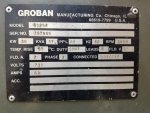I start fires
Member
- Location
- Litchfield, Connecticut, USA
he 'thinks' that is how it is wired, he has no manual or drawings
I believe the nameplate is correct
45 kw
120/208
1 ph
but who knows without opening up and looking at it
I did open it up. The leads are labeled T-1 through T-12 clearly.
They are connected exactly as the drawing shows.
Two 120 volt deltas joined at a corner.
They are however, larger gauge leads than I originally thought, more like #4's.
This is also an original owner machine. Nobody has ever tampered with it.
So you can put to bed the theory that it is wired differently than the drawing.
This removes one variable from equation.


